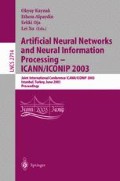Abstract
Many popular probabilistic models for temporal sequences assume simple hidden dynamics or low-dimensionality of discrete variables. For higher dimensional discrete hidden variables, recourse is often made to approximate mean field theories, which to date have been applied to models with only simple hidden unit dynamics. We consider a class of models in which the discrete hidden space is defined by parallel dynamics of densely connected high-dimensional stochastic Hopfield networks. For these Hidden Hopfield Models (HHMs), mean field methods are derived for learning discrete and continuous temporal sequences. We also discuss applications of HHMs to learning of incomplete sequences and reconstruction of 3D occupancy graphs.
Access this chapter
Tax calculation will be finalised at checkout
Purchases are for personal use only
Preview
Unable to display preview. Download preview PDF.
References
Williams, C.K.I., Hinton, G.E.: Mean field networks that learn to discriminate temporally distorted strings. In: Connectionist models: Proceedings of the 1990 summer school. Morgan Kaufmann (1991)
Ghahramani, Z., Jordan, M.: Factorial Hidden Markov Models. In: NIPS. Volume 8., MIT Press (1995)
Hertz, J., Krogh, A., Palmer, R.G.: Introduction to the Theory of Neural Computation. MA: Addison-Wesley Publishing Company (1991)
Neal, R.M.: Connectionist Learning of Belief Networks. Artificial Intelligence (1992) 71–113
Saul, L., Jaakkola, T., Jordan, M.: Mean Field Theory for Sigmoid Belief Networks. Journal of Artificial Intelligence Research 4 (1996)
Agakov, F.V., Barber, D.: Temporal Hidden Hopfield Models. Technical Report EDI-INF-RR-0156, Division of Informatics, University of Edinburgh (2002)
Barber, D., Sollich, P.: Gaussian Fields for Approximate Inference. In Solla, S.A., Leen, T., Müller, K.R., eds.: Advances in Neural Information Processing Systems 12. MIT Press, Cambridge, MA (2000) 393–399
Roweis, S.: Constrained Hidden Markov Models. In: NIPS. Volume 12., MIT Press (1999)
Bishop, C.M., Hinton, G.E., Strachan, I.G.D.: GTM Through Time. In: IEE International Conference on Artificial Neural Networks. (1997)
Author information
Authors and Affiliations
Editor information
Editors and Affiliations
Rights and permissions
Copyright information
© 2003 Springer-Verlag Berlin Heidelberg
About this paper
Cite this paper
Agakov, F.V., Barber, D. (2003). Approximate Learning in Temporal Hidden Hopfield Models. In: Kaynak, O., Alpaydin, E., Oja, E., Xu, L. (eds) Artificial Neural Networks and Neural Information Processing — ICANN/ICONIP 2003. ICANN ICONIP 2003 2003. Lecture Notes in Computer Science, vol 2714. Springer, Berlin, Heidelberg. https://doi.org/10.1007/3-540-44989-2_14
Download citation
DOI: https://doi.org/10.1007/3-540-44989-2_14
Published:
Publisher Name: Springer, Berlin, Heidelberg
Print ISBN: 978-3-540-40408-8
Online ISBN: 978-3-540-44989-8
eBook Packages: Springer Book Archive

